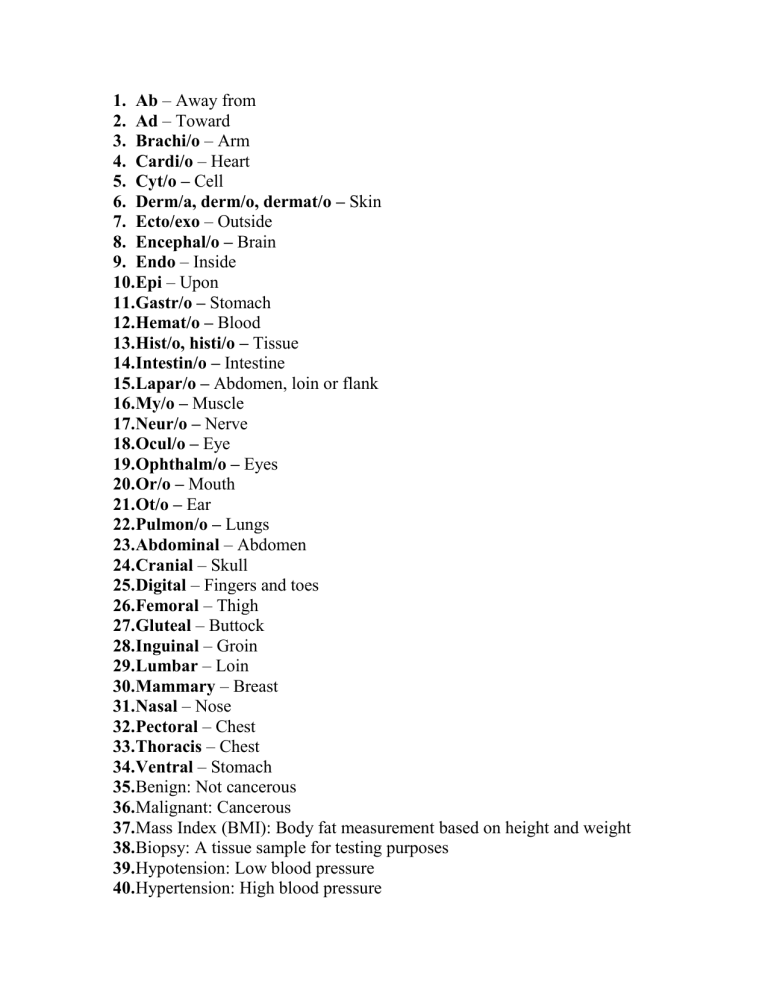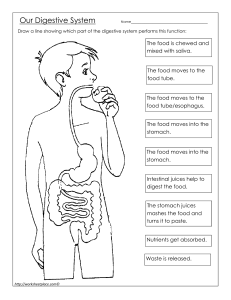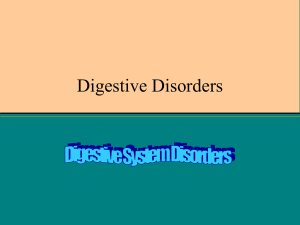
1. Ab – Away from 2. Ad – Toward 3. Brachi/o – Arm 4. Cardi/o – Heart 5. Cyt/o – Cell 6. Derm/a, derm/o, dermat/o – Skin 7. Ecto/exo – Outside 8. Encephal/o – Brain 9. Endo – Inside 10.Epi – Upon 11.Gastr/o – Stomach 12.Hemat/o – Blood 13.Hist/o, histi/o – Tissue 14.Intestin/o – Intestine 15.Lapar/o – Abdomen, loin or flank 16.My/o – Muscle 17.Neur/o – Nerve 18.Ocul/o – Eye 19.Ophthalm/o – Eyes 20.Or/o – Mouth 21.Ot/o – Ear 22.Pulmon/o – Lungs 23.Abdominal – Abdomen 24.Cranial – Skull 25.Digital – Fingers and toes 26.Femoral – Thigh 27.Gluteal – Buttock 28.Inguinal – Groin 29.Lumbar – Loin 30.Mammary – Breast 31.Nasal – Nose 32.Pectoral – Chest 33.Thoracis – Chest 34.Ventral – Stomach 35.Benign: Not cancerous 36.Malignant: Cancerous 37.Mass Index (BMI): Body fat measurement based on height and weight 38.Biopsy: A tissue sample for testing purposes 39.Hypotension: Low blood pressure 40.Hypertension: High blood pressure 41.Lesion: Wound, sore, or cut 42.Noninvasive: Doesn’t require entering the body with instruments; usually simple 43.Outpatient: Check in and check out the same day 44.Inpatient: Plan to stay overnight for one or more days 45.In remission: Disease is not getting worse; not to be confused with being cured 46.embrane: Thin layer of pliable tissue that serves as a covering or lining oconnection between two structures 47.Acute: Sudden but usually short (e.g., acute illness) 48.Angina: Pain in the chest related to the heart that comes and goes 49.Gastroesophageal Reflux Disease (GERD): Heartburn 50.Cellulitis: Inflamed or infected tissue beneath the skin 51.Epidermis: Outermost layer of skin 52.Neutrophils: Most common type of white blood cell 53.Edema: Swelling 54.Embolism: Blood clot 55.Sutures: Stitches 56.Polyp: Mass or growth of thin tissue 57.Compound fracture: Broken bone that protrudes through the skin 58.Comminuted fracture: Broken bone that shatters into many pieces 59.COPD: Chronic obstructive pulmonary disease. 60.ECG: Electrocardiogram. An electrical recording of activity of the heart. May indicate either angina or a heartbeat rhythm problem. 61.ECT: Electroconvulsive Therapy. Used in the treatment of severe depression. 62.OEDEMA: Fluid in the tissues. 63.NEURITIS: Inflammation of neural tissue. 64.NEUROSIS: A mental condition with many variations, but most commonly with anxiety due to various causes such as stress or previous difficult life experiences. The personality is usually not severely affected. 65.EEG: Electro-encephalogram. An electrical recording of brain activity. 66.EPISTAXIS: Bleeding of the nose. 67.GASTRITIS: Inflammation of the lining of the stomach, with pain and/or vomiting. 68.GASTRO-ENTERITIS: Inflammation of the stomach and intestine, with vomiting and/or diarrhoea. 69.HAEMATEMESIS: Vomiting of pure blood or blood mixed with stomach contents. 70.HYPERGLYCAEMIA: A blood sugar level above normal, which is indicative of diabetes. 71.PNEUMOTHORAX: Condition with increase in air pressure in the chest cavity resulting in collapse of the lung. 72.PROGNOSIS: The likely final medical outcome of an illness, in terms of time and condition. 73.HYPERTENSION: Blood pressure above normal; sometimes inaccurately used to describe stress. 74.HYPERVENTILATION: Breathing at a rate above normal, and often due to anxiety. 75.HYPOGLYCAEMIA: A low blood sugar level. Usually due to an excessive insulin dose. Compare to HYPERGLYCAEMIA. 76.HYPOTENSION: Low blood pressure. 77.JAUNDICE: Yellow discolouration of the skin and eyes due to liver disease. 78.MORBIDITY: Description of the outcomes of disease. 79.Anterior/Ventral: At or near the front surface of the body 80.Posterior/Dorsal: At or near the real surface of the body 81.Superior: Above 82.Inferior: Below 83.Lateral: Side 84.Distal: Farthest from center 85.Proximal: Nearest to center 86.SPLEEN: A richly perfused organ in the upper left abdominal area which is unfortunately prone to trauma. It is part of the immune system. 87.SPUTUM: Phlegm (secretions coughed up from the lungs). 88.STERNUM: The middle chest bone where ribs from each side of the body meet. 89.PALLIATIVE CARE: Care aimed at minimizing pain and suffering without aiming to effect a cure. 90.PALPITATIONS: Awareness of the heartbeat; not necessarily due to heart disease. 91.PANCREAS: A gland that lies behind the stomach. It produces insulin. 92.PANCREATITIS: Inflammation of the pancreas organ. 93.PARALYSIS: Loss of movement of any part of the body due to nerve damage. 94.ACUTE: When applied to a medical condition, this term means 'of severe, sudden, but short duration'. As opposed to CHRONIC. 95.ACUTE MYOCARDIAL INFARCTION: Onset of sudden damage to part of the heart muscle, usually due to blockage of the heart's (coronary) arteries. Synonymous with a heart attack. 96.DELIRIUM TREMENS (the DTs): A serious state of delirium due to alcohol withdrawal. Due to overactivity of the nervous system. 97.DELUSION: A false idea or belief held by a person that cannot be corrected by reasoning. 98.Oophorectomy: excision of the ovary 99.Cystectomy: excision of the bladder Excision: to remove or take out 100.



